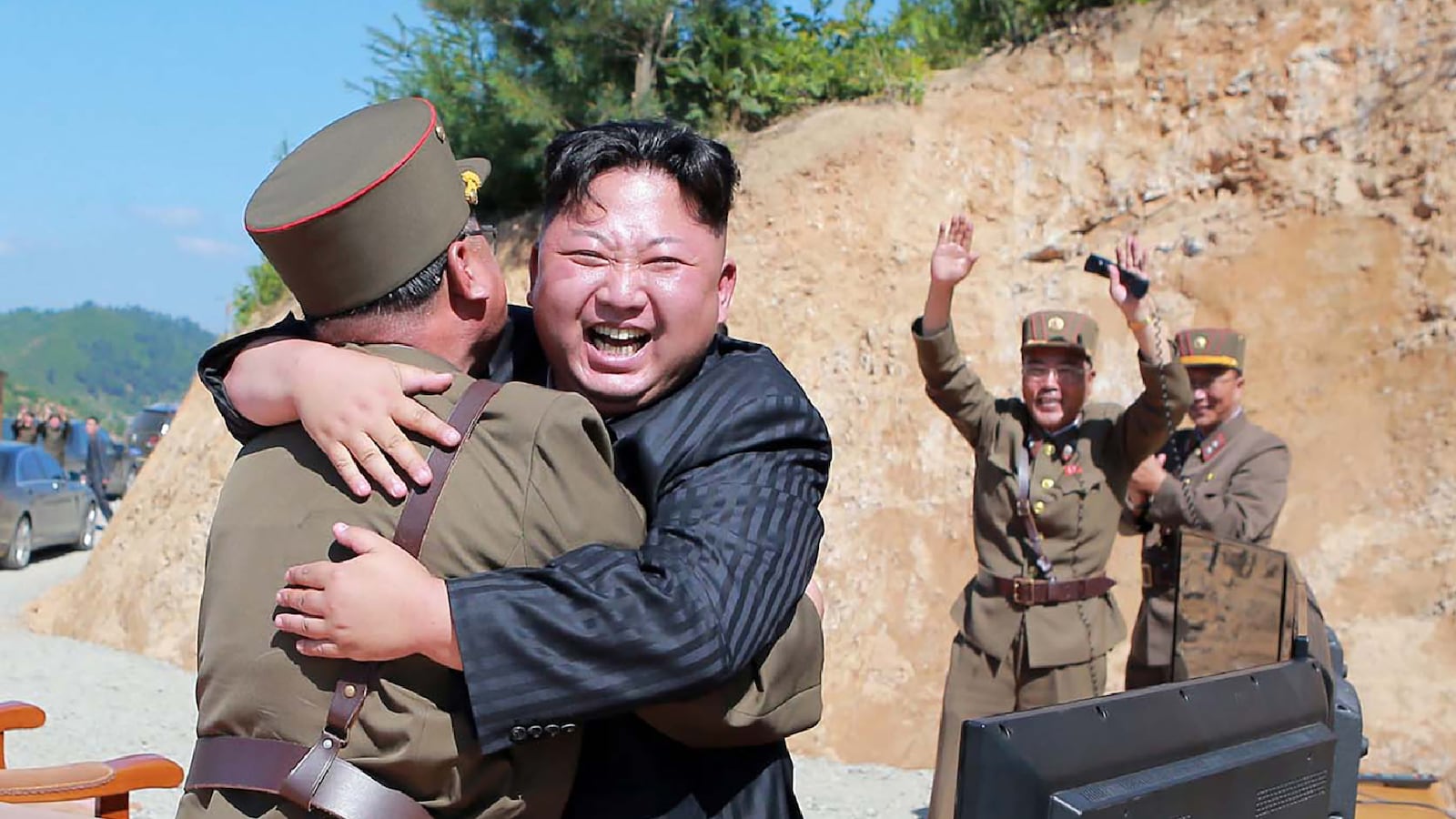The perpetual stand-off between North and South Korea reached crisis level Wednesday with South Korea’s liberal President Moon Jae-in calling the South’s brand-new ballistic missile a “deterrent” against the North and North Korean leader Kim Jong Un’s kid sister jumping in with a strongly worded warning.
The exchange came as both North and South Korea fired off missiles in an escalation of tensions after the U.S. envoy on North Korea met with his Japanese and South Korean counterparts to talk about fresh attempts at often futile dealings with the North.
Seoul’s missile test was a rare show of strength that analysts said demonstrated the president’s “loss of confidence” in the U.S. ability to negotiate peace with the North.
Indeed, the competing tests showed the failure of a series of U.S. presidents to come to viable terms with North Korea. If nothing else, President Biden appears no more capable than Donald Trump, in three meetings with Kim Jong Un, to get the North to back down on his nukes and missiles. Nor would Biden, going back to his days as vice president under President Obama, be able to report any progress since Obama indulged in “strategic patience” with Kim Jong Il, from whom Kim Jong Un inherited power in 2011.
“North Korea uses U.S.-South Korean military exercises and Seoul’s augmentation of its military forces as justification for its repeated violations of UN resolutions,” said Bruce Klingner, Korean expert at the Heritage Foundation, “but Pyongyang continued augmenting its missile and nuclear forces despite Washington and Seoul canceling and reducing numerous military exercises during the past three years.”
True, “North Korea has so far refrained from the large-scale provocations it historically did in the first year of a new U.S. or South Korean administration,” said Klingner, formerly a CIA analyst, “but it appears only a matter of time before Pyongyang conducts another ICBM launch or nuclear test. Either would severely test U.S. leadership in the region.”
Moon, who has been staking his prestige on achieving harmony with North Korea, departed from his quest for reconciliation long enough to witness a test of the South’s newly developed submarine-launched ballistic missile.
Just as North Korea’s leader Kim Jong Un has often ordered and witnessed missile tests, so Moon was on hand with his defense minister, Suh Wook, to observe the SLBM being fired from a submarine. In a comment that seemed surprisingly similar to Kim Jong Un praising his own team for their successes, Moon lavished praise on those responsible for “securing defense capabilities.”
Moon pointedly did not say exactly whom the missile would be defending against, but Kim Jong Un’s little sister, Kim Yo Jong, still found his remarks to constitute “slander” against the North in a “foolish” gesture capable of disrupting North-South relations.
By putting up his sister to make critical comments, Kim Jong Un managed—as he has in recent years—to distance himself somewhat from acrimonious debate with Moon. There was no doubt, however, that his sister’s comments were another attempt at drawing Moon away from close defense ties with the U.S.
Yo Jong seemed more concerned about Moon’s comments than she did about the missile test, staged several hours after the North tested a couple of short-range missiles. The North’s latest missile tests, revealed by South Korea’s defense command, came three days after the North tested a new model of a cruise missile.
One analyst saw the North’s test as having multiple aims.
“One purpose is to respond to Seoul’s recent SLBM testing and demonstrate that North Korea does not intend to stand still as the ROK develops this new capability,” Evans Revere, a former senior U.S. diplomat in Seoul. “Another is to show that the DPRK is doing exactly what Kim Jong Un said it would do earlier this year, i.e, further develop its missile and nuclear weapons capabilities.”
Then, said Revere, “a third goal is to increase the sense of threat and urgency felt by the United States, South Korea, and Japan as the three partners consult on how to bring North Korea back to the negotiating table. By ramping up the threat, Pyongyang seeks to compel the three to increase the concessions they might be prepared to pay North Korea.”
Finally, he said, “Pyongyang is also laying down a marker with Seoul to get the South to press the United States even harder to ease sanctions and offer rewards and concessions to North Korea. North Korea has learned that there is almost no limit to the insults and threats that South Korea is prepared to tolerate and still be willing to plead with the United States to ease pressure on Pyongyang.”
Moon, having repeatedly during his presidency sought reconciliation by severely limiting joint exercises with U.S. forces, said the test of the new SLBM would “make the people feel more relieved and proud,” according to the South’s defense ministry.
“The recent missile tests by both North and South Korea reflect not only the military competition between the two regimes but also their efforts to increase the deterrence of threats they perceive as coming from Japan and China,” said David Straub, also a former senior U.S. diplomat in Seoul. “In the case of South Korea, the tests are also a response to a loss of confidence in the United States as an ally after two decades of catastrophic American failures militarily (Afghanistan and Iraq), financially (the Great Recession), politically (the election of Trump as president), and socially (the inability of Americans to respond sensibly and effectively to a pandemic).”
Moon’s office put out a statement claiming the SLBM had “a significant meaning for defense capabilities responding to omnidirectional threats”—a turn of phrase intended to show that the missile was not for use solely against North Korea. In fact, said the statement, as reported by South Korea’s Yonhap news agency, the missile “will play a big role in establishing nati0nal self-defense and peace on the Korean peninsula”–again a phrase that could be interpreted to mean the missile could conceivably come in handy in defending both Koreas—and a united Korea.
The attempt at proving that Moon still hoped to restore dialogue with the North was not convincing, however, considering that the North had just fired off short-range ballistic missiles off its east coast. They have a range of about 500 miles, but Japanese defense officials said the missiles, unlike previous North Korean test shots, had not landed in Japan’s “exclusive economic zone.”
Still, the test drew a sharp denunciation from Japan’s Prime Minister Yoshihide Suga as well as from both U.S. and South Korean officials. Coming right after talks among U.S., Japanese, and South Korean envoys, they appeared to be North Korea’s way of warning against trilateral cooperation.
U.S. envoy Sung Kim was clearly just as interested in getting South Korea to coordinate with Japan against the North as he was in encouraging a resumption of dialogue, which abruptly ended after the abortive summit between Donald Trump and Kim Jong Un in Hanoi in February 2019.
In the face of often strained relations with Japan, South Korea’s foreign ministry said they could see eye to eye on at least one thing: “the need for management of a stable situation.” NK News in Seoul quoted the ministry as saying they talked about “in-depth cooperation measures to restart the peace process on the Korean peninsula and agreed that dialog and diplomacy are urgent to achieve complete denuclearization.”
The careful South Korean response on talks with Japan and the U.S. showed Seoul’s desire somehow to avoid controversy in the face of comments such as those from Kim Yo Jong. “Kim has restarted his blackmails,” said a former South Korean intelligence official. With only eight months to go in Moon’s presidency, he said, “nothing he does may change.”







